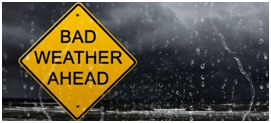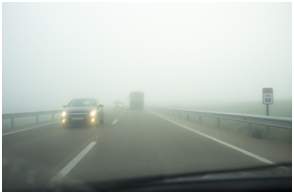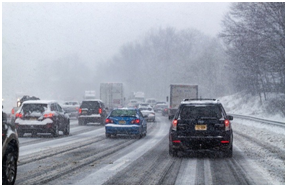Drivers are often challenged by the bad weather during their driving, and it is unavoidable. So, how can you deal with these harsh weather conditions? Don’t worry, keep reading this post and you will find more safe driving tips for extreme weather.

There are some extreme types of weather such as cloudiness, fog, blizzards, ice, rain, heavy wind, hail, snow, tornados, and thunderstorms. Obviously, these weather conditions involve a lot of risks, requiring you to prepare for accident prevention at any time. Here are some common dangers that you should pay attention to:
Contents
Losing control
The slippery scenario is relatively common during extreme weather. Even if it rains or snows, the bad weather still impacts roads, making the tire traction lower. It is advisable to drive slowly and keep a safe pace from other front vehicles so that you can avoid accidents.
If you cannot control your vehicle, unfortunately, stay calm and slow down your car speed. At the same time, you keep your car wheels aimed at the place you are about to go. In fact, this situation is really hard to deal with, but if you can be calm and careful at first, the influence will be lessened.
Limited visibility
The limited visibility might have resulted from the poor light, debris, or vision obstruction. This problem seems to be more common than any others, not even during the bad weather. In case you do not have clear visibility, you have to drive very carefully to keep safe for yourself and your surroundings.
If the situation becomes worse, you should pull over anywhere that you feel safe. Wait for the worst pass. Besides, you can activate the low beam headlights. Last but not least, keep in mind to drive slowly and maintain a great distance from other vehicles.
Road and driving safety in the extreme weather
Protect your car
Stay full
The fuel efficiency is often reduced by the cold weather. Thus, you should keep the gas at an average level, about half-full. Also, topping up the gas before your trip is not a bad idea. By doing that, your vehicle will not run out of fuel in emergencies, and you can protect the gas line’s integrity.
Plugin
Every driver knows that the car battery will be weakened by the cold conditions so that you cannot start the car immediately. So, if the temperature drops to -15°C and under, you ought to have the heater plugged in.
Use winter tires
In fact, winter tires can level up the overall control of the vehicle on slippery or icy roads, in consisting of steering or stopping distance. However, it is better to use four identical wheels and maintain them at the recommended air pressure. Checking the tire pressure frequently is a must.
Use synthetic oil
The reason why you had better use synthetic oil is that it will reduce the engine wear and extend the engine lifespan. Compared to the conventional oil, this one will not thicken during the winter.
Protect yourself
Prepare an emergency kit
You should put some stuff such as winter clothing, a first aid kit, road cones, blankets, and food items.
Dress warmly
To be ready for the worst scenario, you should dress in comfortable and warm clothes. Besides, put some extra winter clothing into your vehicle so that you have enough clothes for everyone to keep warm if the breakdown happens.
Charge your phone
The mobile phone is the greatest way to ask for help when you are unluckily stranded. Keeping your mobile charged may guarantee the availability of a lifeline. Thus, you should always store a charger in your car.
Keep clear

Before driving, you had better clear the windows, lights, and windshields. The more visibility you get, the safer your driving experience is. Also, you can think about having winter wiper blades as their rubber design is used for extreme weather.
Adjust the spacing and speed
There are some limitations for speed in the worst conditions. Aside from driving slowly, leaving a large space between your car and other vehicles can prevent major and minor accidents. Notice the road carefully and look out for emergency responders. If it is necessary, you can slow down your car to 60 km/h or lower.
Driving tips in the snow
- Avoid a spinout.
- Employ extreme caution on overpasses and bridges.
- Give snowplows a lot of room.
- Stop quickly.
- Keep the 9-second following distance.
Driving tips in the rain
- Always improve your visibility.
- Use polarized sunglasses.
- Increase the traction.
- Watch out for the surface of the road.
- Check all the lights.
- Use the water repellant for the windshield.
Driving tips on the ice
- Pay attention to the dangerous temperature range.
- Find and use the water spray.
- Being aware of ice on overpasses and bridges.
- Activate the detection system of black ice.
- Do not make sudden movements or hit the brake.
Driving tips in the fog
- Maximize the defroster and the windshield wiper.
- Do not employ the high beams.
- Keep a long following distance.
- Watch out and follow the road lines to ensure you stay in the right lane.
- Stop and pull into a parking lot, side street, or driveway if you find yourself cannot drive due to the thick fog.
Driving tips in high winds
- Avoid cornering or taking turns fast.
- Do not drive with a high profile.
- Steer away from trucks, trailers, and other things that are towed.
- Be extra careful and look out for any objects which may be blown on the roads.
- Avoid panic but stay calm.
The bottom line
Above are lots of safe driving tips for extreme weather that you want to know. Remember that the more awareness you apply and gain on the road, the better you can reduce and prevent road crashes. Hope that you find this article helpful, and you can share the advice on safe driving with your family and friends.
